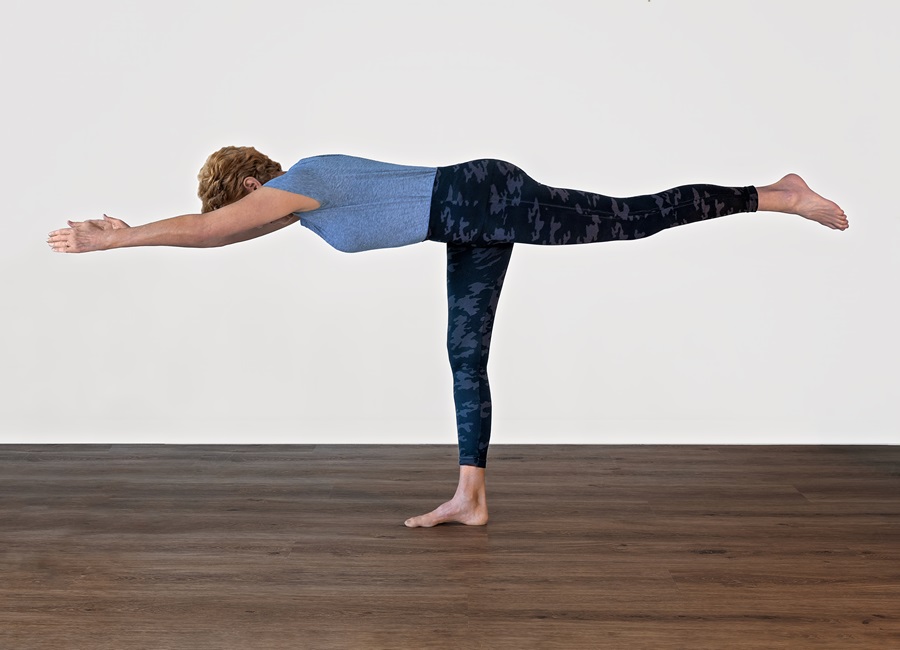Strength, balance, and fortitude. These are surely the qualities a person who is pursuing a spiritual path would need. But it seems to me they are also important qualities for anyone living in our times.
Virabhadrasana III, also called Warrior 3, is a yoga pose that focuses on developing these capacities. Most everyone finds it challenging. So much so that considering the many ways of supporting yourself and adapting the pose to make it more friendly for your body may be more important than actually winding up in the pose. I love this about yoga.
A yoga practice is about being on a path, not getting to a destination. You start where you are and adapt the poses according to your needs. Along the way, you build strength and skill. It is a learning process — physical, psychological, and spiritual — about yourself and about life. Which is why having a regular practice is so important.

When I was younger, I injured myself several times doing yoga. In my exuberance, I would push myself beyond my limits, and it took me years to begin to listen to my body and let it guide me. Only then did I learn that I could get the benefits of the poses by going more slowly and working my way in over time, and that, in the end, perfection was not the goal. A good life lesson.
Yoga teaches us to be real about who we are and to grow with wisdom and compassion. So, slowly, let’s see what there is to learn in Warrior 3.
- Begin by standing at the back of your yoga mat.
- Stand in Tadasana or Mountain pose, with your feet parallel, hip-width apart. Feel your body extending upward as your arms extend down by your sides.
- Take a deep breath and step your right foot forward 3 to 4 feet. Bend the right knee, keeping it aligned over the ankle. Turn your left foot out 45 degrees as the right foot continues to point straight in front of you. Exhaling, draw your right hip back, bringing your hips parallel to each other.
- Raise your arms, energizing them to lift you out of your waist.
- Press down into your right foot and engage your core by drawing the muscles a few inches below your navel in and up. Tuck in your lower ribs.
- Come up onto the toes of your back foot. Begin to shift all your weight into the front leg as it straightens. The arms and the body reach forward parallel to the floor and the back leg comes up in line with them. Be careful not to over-straighten your standing leg. You don’t want to lock the knee and put strain on the joint.
- Think stability. Now that you’re in the pose, there are several things you can do to stabilize yourself here. Engage the muscles of your right outer hip but keep your hips in line with each other. Keep your head between your arms, the crown of the head reaching forward as the arms and hands reach out in tandem. Your hands face each other. Keep your core active and direct your tailbone towards your left heel.
- Try expansion. Reach your arms and your extended leg in opposite directions. At the same time, feel your standing leg and foot extending to the floor, grounding you. This takes focus and concentration. Now repeat the pose on the other side.
For many people, balancing on one leg like this is not possible. So how to be on the path to this pose? There are many ways to adapt Warrior 3 so you can build strength and get its benefits of it without losing your balance.
One way to support yourself into this pose is by doing it with two yoga blocks standing on end in front of you like two little pillars. Instead of stretching your hands out in front of you, bend forward and place your hands on the blocks. Proceed with the pose from here. You’ll also find this version easier on your shoulders and arms.
Another approach is to place a chair 3 or 4 feet in front of you with the back of the chair facing you. Hinge forward at the hips and take hold of the back of the chair as you lift your back leg. You can also do the pose using a wall for stability; place your hands on the wall or, if you’d rather, rest your back foot on the wall.
For a gentle start, you could also begin in a tabletop position, on all fours, rather than standing. Place a blanket under your knees for cushioning and practice lifting one leg behind you at a time, raising it up to hip height. As with the standing pose, keep the hips in line with each other. Then try lifting one leg and the opposite arm. Now you’re building balance and strength. Be sure to use your core just as you would if you were standing.
Getting into this pose, you can feel how it strengthens your legs, ankles, and feet, and your core, shoulders, and back. But there’s something else about it that isn’t so much about the parts of your body but about your sense of it. In that way, it strengthens your proprioceptive system, which keeps you in balance and oriented in space.
Be gentle with yourself and go slow as you let your body be rooted and yet expansive at the same time. It’s only February, after all — you’ve got half a winter ahead for exploring this path.
